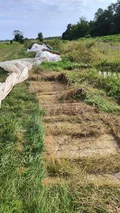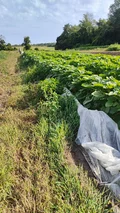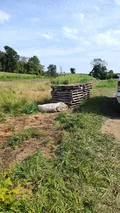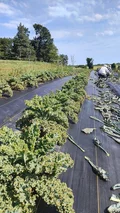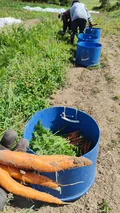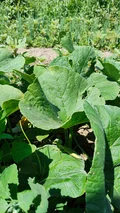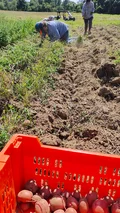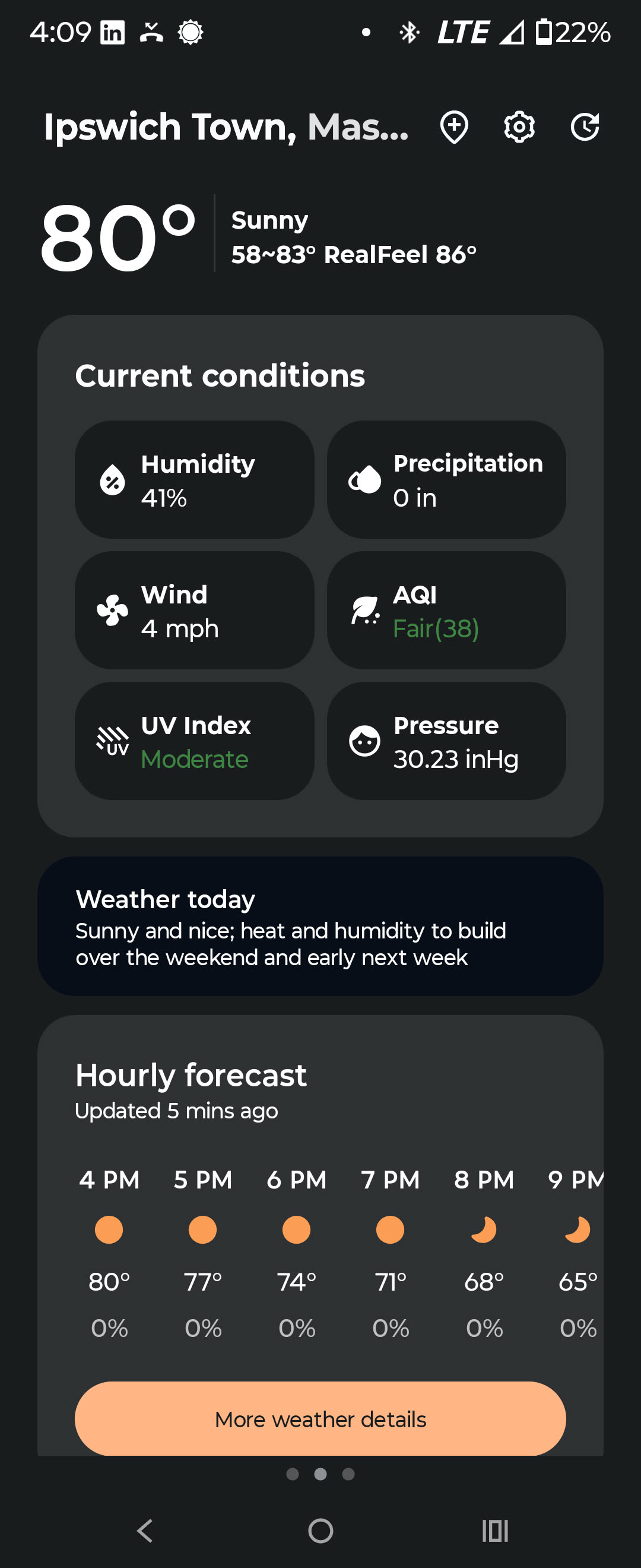TL;DR
Friday field work involved cleaning feed piles, harvesting carrots, and preparing kale for regrowth.
Everything Old is New (to Someone)
On any given day, we have a rotating crew of staff with the occasional weekly volunteer. Last year, I was the latter and now I’m the former. This was my first Friday on the farm because I usually reserve the last day of each week for my tech contract work and scheduled meetings, but due to a car repair on Wednesday I deferred to Friday as a farm work day.
On Friday’s, farmer Jamie takes one other person to pack up the van and go to the Annisquam pick-up location in Gloucester and as such, the second hand person usually leads the crew. Today that person was out so the team of 6 was left with a few key tasks to complete until noon…nothing complicated but we got it done together.
Even with regular staff, there’s always something that each of us haven’t done before. While many of these tasks are routine and not too complicated, there are always details that matter and some that don’t. The one’s that do are usually very important. The way people often learn about new things is by experience and intra-team ‘knowledge transfer’. Riding along and assisting someone is the best way to learn how to differentiate between the two.
Because of the autonomy in today’s work situation, it was the first time I really felt like was less of a ride-along and more of a ride-with. Yesterday I helped someone learn how to drive a Gator. Today I tasked some folks with helping me with chicken chores. It’s a small thing to some people, but to me was a step in a new direction. Humans have been doing these things for tens of thousands of years, but not me, not everyone on this staff. Everything is new to someone at some point, even ‘old ways’ like farming. Despite all of this, modern kale is resilient and doesn’t require training, just a little attention across the season:
Out with the Old, in with the New
The very moment we clean up the fields of random seasonal resource debris like old pallets once stacked high with non-GMO chicken and pig feed, the delivery truck arrives with new palettes of that and other much-needed agricultural supplies.
This cycle of ‘out with the old, in with the new’ is happening in some way on the farm almost every day. Movement is the medium by which change is materialized. For instance:
- A ‘secret carrot bed’ opportunistically sown two months ago replaces last week’s finalized beds
- Just as we almost run out of feed palettes, new ones arrive
- Lettuces and bok choy are planted and irrigated while cilantro and basil go to seed
- Kale all but exhausted by heat and pest damage is stripped in prep for fall harvesting
I wonder if the pigs and chickens think similar thoughts about how fortunate it is to have food and water delivered to them every day. Lots of things I wonder and ask about to Jamie are answered with a calm, considered, and sometimes cryptic response. I’ve learned to not ask about things I’ll just see in action in a few minutes or hours, and rather ask about things I couldn’t have seen or done myself.
I have my doubts but maybe at some point in the future, I’ll find myself the ‘primary’ (a.k.a. ‘actual’) on a farm. If there are inquisitive people who choose to work with me, I’ll remember what I was patterned which is to be calm, considered, and cryptic as the situation calls for.
Secret Carrot Party
Once upon a time there was an empty row and and this row was intended to be seeded with dill. When being weeded, this row turned out to be carrots. Seed packets and labels (like human wherewithal) can sometimes be faded by dampness and sun exposure, but in haste can also be mistaken for each other since the seeds are very small.
The moon might be full, the mosquitoes might be hungry, the rain comes not enough and then too much, the in-laws might be visiting, the radio might be inundated with terrible news, the summer youth programs might be kicking off, the years might be passing. And frankly, nature doesn’t care.
If you ask me, this was a ‘beautiful oops’ because as much as I (and more importantly my wife) love dill, carrots are just better in every way. Customers do too because sometimes everyone agrees about a thing. The good news is that staff and customers alike get to have a “secret carrot party” because even in a short row in the right field, there are over 200 bunches of carrots we’re only half-way through as of today.
A Pipeline for Learnings and Activities
Today I put in a solid day’s effort on the farm which because it’s what I’m paid to do. This is also the only time I record audio notes as a basis for these blog posts, so if I don’t work, I don’t have notes or a blog post to publish. Missing a day this week due to car repairs gave me time to work on the tech process but drove my anticipation of Friday’s (today’s) field work.
On Wednesday, I focused on validating recent additions to the automated process. Yesterday and today, the process worked very well, proposing the next [correct] command line tasks to be performed at each stage of the process. These eventually will be put in a background container, likely in the Kube cluster, but are all simple shell scripts and Python utilities. Both writing and validating new code are activities that must go hand-in-hand.
This week’s adjustments to this pipeline didn’t change the AI-generated summary quality or accuracy…all it did was speed the content publishing process. Working on this pipeline both from a content and process perspective is a great way to progressively prototype just what is needed at the right time.
AI Summary from Field Notes
Here’s what my AI assistant thinks I did today:
Main Themes
- Crop Management: Focus on seed labeling, row cover removal, and irrigation practices.
- Technical Tools: Use of tractor attachments for cultivation and irrigation systems.
- Market Coordination: Preparation for the Annisquam market with consistent supply management.
- Sustainable Practices: Monitoring crop growth and regrowth effects (e.g., kale stripping).
- Operational Efficiency: Standardizing processes for seed handling, row cover removal, and irrigation.
Activities Performed
- Seed Handling: Addressed label confusion and misidentification risks.
- Row Cover Removal: Removed sunflower row covers left in the ground for weeks.
- Irrigation Setup: Installed hose systems for watermelons and lettuces.
- Crop Maintenance: Stripped kale to top leaves for regrowth assessment.
- Market Prep: Coordinated with the Annisquam market team for consistent supply and preparation.
New Things Encountered
- Seed Label Erosion: Labels on seeds may become illegible, leading to misidentification.
- Tractor Attachment Use: A specialized tool for potato cultivation.
- Row Cover Removal: Manual removal of row covers left in the ground.
- Irrigation Planning: Installing a system for watermelons and lettuces.
Questions and Future Research
- Seed Labeling: How to preserve seed labels for accuracy?
- Row Cover Timing: Optimal timing for removing row covers to avoid growth interference.
- Kale Stripping Impact: Effect of stripping kale on regrowth and yield.
- Irrigation Effectiveness: How does the new system affect watermelon and lettuce growth?
Suggested Actions
- Seed Label Protocol: Implement durable labeling systems or protective covers.
- Equipment Training: Train staff on tractor attachment use for cultivation.
- Row Cover Documentation: Record removal practices for standardization.
- Irrigation Monitoring: Track crop growth under the new irrigation system.
- Market Coordination Routine: Establish a consistent schedule for market prep and supply management.
Part 1
Main Themes
- Farm Operations and Maintenance: Daily tasks involving crop preparation, harvesting, and field maintenance.
- Collaborative Work: Team efforts during market prep and farm chores, including roles in cleaning, harvesting, and equipment use.
- Seasonal Crop Management: Preparing crops for regrowth (e.g., kale stripping, sunflower row cover removal).
- Labor-Intensive Tasks: Physical work involving manual labor, machinery use, and logistics (e.g., moving pallets, rolling tarps).
- Market Preparation: Preparing for a market in Annisquam, including coordinating with the crew and managing supplies.
Activities Performed
- Market Preparation:
- Pack up supplies (van, tarps, pallets) for the Annisquam market.
- Coordinate with the Friday crew for market logistics.
- Field Cleanup and Consolidation:
- Consolidated feed and soil amendment piles to make space for new deliveries.
- Moved pallets and rolled tarps for storage.
- Crop Management:
- Removed sunflower row covers (left in the ground for weeks).
- Stripped kale to leave only top leaves for regrowth.
- Harvested 100 bunches of carrots (extra crop due to label confusion).
- Harvested tomatoes and weeded squash/cucumbers.
- Equipment Use:
- Used a tractor attachment to cultivate potatoes.
- Set up irrigation hose for watermelons and lettuces.
- Animal Care:
- Chores for chickens and pigs (not detailed, but implied).
- Field Maintenance:
- Closed the barn and checked irrigation systems.
- Ensured water access for watermelons and lettuces.
New Things Encountered
- Label Confusion in Seeds:
- Observed that seed labels may erode or become illegible, leading to potential misidentification (e.g., dill vs. carrots).
- Tractor Attachment Use:
- Used a specialized tool for cultivating potatoes, which may be a new or less-familiar task.
- Sunflower Row Cover Removal:
- Removed row covers that had been left in the ground for weeks, a task requiring careful handling.
- Irrigation Setup:
- Installed irrigation hose across a field for watermelons and lettuces, a logistical task requiring planning.
Questions and Future Research
- Seed Labeling Issues:
- How can seed labels be preserved or verified to prevent misidentification?
- Are there alternative labeling systems or storage methods to avoid erasure?
- Row Cover Management:
- What is the optimal timing for removing row covers to avoid interfering with plant growth?
- Are there alternatives to manual removal (e.g., mechanical tools)?
- Kale Stripping Effectiveness:
- How does stripping kale to only top leaves affect its regrowth or yield?
- Is this practice common in other crops?
- Irrigation Efficiency:
- How does the irrigation setup for watermelons and lettuces impact their growth?
- Could the system be adapted for other crops?
Suggested Actions
- Develop a Seed Labeling Protocol:
- Implement a system to ensure seed labels remain legible (e.g., durable materials, protective covers).
- Train on Equipment Use:
- Provide training for using tractor attachments for crop cultivation.
- Document Row Cover Removal Practices:
- Record the timing and method for removing row covers to standardize processes.
- Monitor Irrigation Impact:
- Track the growth of watermelons and lettuces under the new irrigation system to assess effectiveness.
- Collaborate with Market Crew:
- Establish a routine for coordinating with the Annisquam market team to ensure consistent prep and supply management.
[end of post]
Enjoy Reading This Article?
Here are some more articles you might like to read next:
